Comparison of Urbanization, Climate Change, and Drainage Design Impacts on Urban Flashfloods in an Arid Region: Case Study, New Cairo, Egypt
Abstract
1. Introduction
2. Materials and Methods
2.1. Study Area
2.2. Data Sets
2.3. Modeling
2.4. Methodology
2.4.1. Runoff Modeling Using Historical Urbanization Data
2.4.2. Climate Change Projections Comparison and Evaluation
2.4.3. Drainage Network Evaluation
3. Results
3.1. Impacts of Urbanization on Surface Runoff
3.2. Climate Projections Scenarios Comparison and Its Effect on Flood Volumes
3.3. Effect of the Drainage Design on Urban Runoff Volumes
4. Discussion
- Based on a comprehensive review of the literature, very few studies included drainage design as a factor for urban floods and focused mostly on the effect of climate change and land use change.
- Comparing ground-measured rainfall data with projected climate scenarios for a common period yielded useful insight for future predictions in flood modeling.
- Overcoming data scarcity and shortage and conducting an integrated framework that is considered novel for the area will prove useful for assessing other ungauged basins with similar conditions.
5. Conclusions
Author Contributions
Funding
Data Availability Statement
Acknowledgments
Conflicts of Interest
References
- Narbondo, S.; Gorgoglione, A.; Chreties, C. Improving the Performance of an Operational Flood Early Warning System with the Assimilation of Satellite-Soil-Moisture Data. In Proceedings of the Computational Science and Its Applications—ICCSA 2021, Cagliari, Italy, 13–16 September 2021; Springer: Cham, Switzerland, 2021; pp. 34–46. [Google Scholar]
- Zhou, Q.; Leng, G.; Su, J.; Ren, Y. Comparison of urbanization and climate change impacts on urban flood volumes: Importance of urban planning and drainage adaptation. Sci. Total Environ. 2018, 658, 24–33. [Google Scholar] [CrossRef] [PubMed]
- Asadzadeh, A.; Kötter, T.; Fekete, A.; Moghadas, M.; Alizadeh, M.; Zebardast, E.; Weiss, D.; Basirat, M.; Hutter, G. Urbanization, migration, and the challenges of resilience thinking in urban planning: Insights from two contrasting planning systems in Germany and Iran. Cities 2022, 125, 103642. [Google Scholar] [CrossRef]
- Dodman, D.; Leck, H.; Rusca, M.; Colenbrander, S. African Urbanisation and Urbanism: Implications for risk accumulation and reduction. Int. J. Disaster Risk Reduct. 2017, 26, 7–15. [Google Scholar] [CrossRef]
- United Nations Department of Economic and Social Affairs. Population Division World Population Prospects Highlights, 2019 Revision Highlights, 2019 Revision; United Nations: New York, NY, USA, 2019; ISBN 978-92-1-148316-1.
- Abdrabo, K.I.; Kantosh, S.A.; Saber, M.; Sumi, T.; Elleithy, D.; Habiba, O.M.; Alboshy, B. The Role of Urban Planning and Landscape Tools Concerning Flash Flood Risk Reduction Within Arid and Semiarid Regions. In Wadi Flash Floods. Natural Disaster Science and Mitigation Engineering: DPRI Reports; Sumi, T., Kantoush, S.A., Saber, M., Eds.; Springer: Singapore, 2022. [Google Scholar] [CrossRef]
- Echendu, A.J. Relationship between urban planning and flooding in Port Harcourt city, Nigeria; insights from planning professionals. J. Flood Risk Manag. 2021, 14, e12693. [Google Scholar] [CrossRef]
- Sohail, M.T.; Elkaeed, E.B.; Irfan, M.; Acevedo-Duque, Á.; Mustafa, S. Determining Farmers’ Awareness About Climate Change Mitigation and Wastewater Irrigation: A Pathway Toward Green and Sustainable Development. Front. Environ. Sci. 2022, 10, 193. [Google Scholar]
- Kaykhosravi, S.; Khan, U.T.; Jadidi, M.A. The Effect of Climate Change and Urbanization on the Demand for Low Impact Development for Three Canadian Cities. Water 2020, 12, 1280. [Google Scholar] [CrossRef]
- Negm, A. Flash Floods in Egypt; Springer: Cham, Switzerland, 2020; pp. 3–9. ISBN 978-3-030-29634-6. [Google Scholar]
- Chan, N.W.; Tan, M.L.; A Ghani, A.; A Zakaria, N. Sustainable urban drainage as a viable measure of coping with heat and floods due to climate change. IOP Conf. Series: Earth Environ. Sci. 2019, 257, 012013. [Google Scholar] [CrossRef]
- Lange, M.A. Impacts of Climate Change on the Eastern Mediterranean and the Middle East and North Africa Region and the Water–Energy Nexus. Atmosphere 2019, 10, 455. [Google Scholar] [CrossRef]
- IPCC. Climate Change 2007: Impacts, Adaptation and Vulnerability. Contribution of Working Group II to the Fourth Assessment Report of the IPCC; Cambridge University Press: Cambridge, UK, 2007; p. 976. [Google Scholar]
- IPCC. Contribution of Working Group I to the Sixth Assessment Report of the Intergovernmental Panel on Climate Change; Cambridge University Press: Cambridge, UK, 2021. [Google Scholar] [CrossRef]
- Kershaw, T. Climate Change and Its Impacts. In Climate Change Resilience in the Urban Environment. IOP Publishing: Bristol, UK, 2017. [Google Scholar]
- IPCC. Climate Change 2022: Impacts, Adaptation, and Vulnerability. Contribution of Working Group II to the Sixth Assessment Report of the Intergovernmental Panel on Climate Change; Cambridge University Press: Cambridge, UK, 2022. [Google Scholar]
- Schilling, J.; Hertig, E.; Tramblay, Y.; Scheffran, J. Climate change vulnerability, water resources and social implications in North Africa. Reg. Environ. Chang. 2020, 20, 15. [Google Scholar] [CrossRef]
- ElGanzori, A. Towards a Climate Change Adaptation Strategy for the Water Sector in Egypt; UNESCO: Cairo, Egypt, 2012. [Google Scholar]
- Hamed, M.M.; Nashwan, M.S.; Shahid, S. Climatic zonation of Egypt based on high-resolution dataset using image clustering technique. Prog. Earth Planet. Sci. 2022, 9, 1–16. [Google Scholar] [CrossRef]
- Gado, T.A.; El-Hagrsy, R.M.; Rashwan, I.M.H. Spatial and temporal rainfall changes in Egypt. Environ. Sci. Pollut. Res. 2019, 26, 28228–28242. [Google Scholar] [CrossRef] [PubMed]
- Elnazer, A.A.; Salman, S.; Asmoay, A. Flash flood hazard affected Ras Gharib city, Red Sea, Egypt: A proposed flash flood channel. Nat. Hazards 2017, 89, 1389–1400. [Google Scholar] [CrossRef]
- IFRC. Flash Floods Emergency Plan of Action (EPoA); Egypt: International Federation of Red Cross and Red Crescent Societies (IFRC). 2020. Available online: https://reliefweb.int/report/egypt/egypt-flash-floods-emergency-plan-action-epoa-final-report-dref-n-mdreg015 (accessed on 13 September 2021).
- MoSS Ministry of Social Solidarity; Egypt. 2020. Available online: https://www.eeas.europa.eu/delegations/egypt/ministry-social-solidarity-european-union-and-undp-sign-%E2%82%AC6-million-project_en?s=95 (accessed on 13 September 2021).
- Abd El-Halim, H. Cairo Governorate Imposes Emergency in New Cairo Due to Rain - Egypt Independent. Egypt Independent. 2019. Available online: https://egyptindependent.com/cairo-governorate-imposes-emergency-in-new-cairo-due-to-rain/5 (accessed on 15 September 2021).
- Arnone, E.; Pumo, D.; Francipane, A.; La Loggia, G.; Noto, L.V. The role of urban growth, climate change, and their interplay in altering runoff extremes. Hydrol. Process. 2018, 32, 1755–1770. [Google Scholar] [CrossRef]
- Jung, M.; Kim, H.; Mallari, K.J.B.; Pak, G.; Yoon, J. Analysis of effects of climate change on runoff in an urban drainage system: A case study from Seoul, Korea. Water Sci. Technol. 2014, 71, 653–660. [Google Scholar] [CrossRef]
- Kleidorfer, M.; Mikovits, C.; Jasper-Tönnies, A.; Huttenlau, M.; Einfalt, T.; Rauch, W. Impact of a Changing Environment on Drainage System Performance. Procedia Eng. 2014, 70, 943–950. [Google Scholar] [CrossRef][Green Version]
- Luo, H.; Oberg, N.; Landry, B.J.; García, M.H. Assessing the system performance of an evolving and integrated urban drainage system to control combined sewer overflows using a multiple-layer based coupled modeling approach. J. Hydrol. 2021, 603, 127130. [Google Scholar] [CrossRef]
- CRED/UNISDR The Human Cost of Weather Related Disasters (1995–2015). 2016. Available online: https://www.unisdr.org/2015/docs/climatechange/COP21_WeatherDisastersReport_2015_FINAL.pdf (accessed on 10 July 2021).
- USGS Shuttle Radar Topography Mission (SRTM) 1 Arc-Second Global. 2017. Available online: https://earthexplorer.usgs.gov (accessed on 10 July 2021).
- Hewaidy, A.G.A.H.; Abu El Hassan, M.; Salama, A.; Ahmed, R. Flash Flood Risk Assessment of Wadi Degla Basin Protected Area, East of Maadi, Cairo, Egypt Based on Morphometric Analysis Using GIS Techniques. Hydrology 2021, 9, 66. [Google Scholar] [CrossRef]
- Mabrouk, N.; Sarnouby, I. Stories After the Disaster [Interview]. Al Dostor Newspaper. 2018. Available online: https://akhbarak.net/news/15488059/articles/30815149 (accessed on 13 October 2021).
- Zhou, Q.; Leng, G.; Huang, M. Impacts of future climate change on urban flood volumes in Hohhot in northern China: Benefits of climate change mitigation and adaptations. Hydrol. Earth Syst. Sci. 2018, 22, 305–316. [Google Scholar] [CrossRef]
- Google Earth New Cairo City, Egypt. 30°1′32.28″N, 31°28′30.57″E, Eye Alt 17 Mi. 2020. Available online: https://earth.google.com/web/@30.01896478,31.47750293,358.18031989a,126098.99097372d,35y,0h,0t,0r (accessed on 9 July 2021).
- ESA Topographical Maps of Egypt 1:100,000 [Report].; Egyptian Surveying Authority (ESA). 1950. Available online: https://maps.lib.utexas.edu/maps/ams/egypt/ (accessed on 9 July 2021).
- RICCAR Background of The Regional Knowledge Hub|RICCAR. Available online: https://riccar.org/welcome-to-the-regional-knowledge-hub. (accessed on 2 July 2021).
- Hafez, R.M. New cities between sustainability and real estate investment: A case study of New Cairo city. HBRC J. 2017, 13, 89–97. [Google Scholar] [CrossRef]
- Farid, M.; El Shafie, H. An Assessment of the New Cairo City. J. Eng. Appl. Sci. 2002, 49, 681–698. [Google Scholar]
- MHUC. ECP Egyptian Code of Practice (102) for Designing Basis of Water and Waste Water Drainage Networks; Egypt Ministry of Housing, Utility and Urban Communities (MHUC): Cairo, Egypt, 2010; Volume 1.
- Awadallah, A.G.; Magdy, M.; Helmy, E.; Rashed, E. Assessment of Rainfall Intensity Equations Enlisted in the Egyptian Code for Designing Potable Water and Sewage Networks. Adv. Meteorol. 2017, 2017, 1–10. [Google Scholar] [CrossRef]
- Awadallah, A.; Younan, N. Conservative design rainfall distribution for application in arid regions with sparse data. J. Arid Environ. 2012, 79, 66–75. [Google Scholar] [CrossRef]
- Cronshey, R. Urban Hydrology for Small Watersheds; US Department of Agriculture, Soil Conservation Service, Engineering Division: Washington, DC, USA, 1986.
- MWRI. In Egyptian Code of Practice for Flood Protection; Ministry of Water Resources and Irrigation of Egypt (MWRI): Giza, Egypt, 2011.
- Riyadh Municipality. Engineering Guidelines for Flood Protection Works; Ministry of Municipal and Rural Affairs: Riyadh, Saudi Arabia, 2017.
- José, R.S.; Pérez, J.L.; González, R.M.; Pecci, J.; Garzón, A.; Palacios, M. Impacts of the 4.5 and 8.5 RCP global climate scenarios on urban meteorology and air quality: Application to Madrid, Antwerp, Milan, Helsinki and London. J. Comput. Appl. Math. 2016, 293, 192–207. [Google Scholar] [CrossRef]
- Moss, R.H.; Babiker, M.; Brinkman, S.; Calvo, E.; Carter, T.; Edmonds, J.A.; Elgizouli, I.; Emori, S.; Lin, E.; Hib-bard, K.; et al. Towards New Scenarios for Analysis of Emissions, Climate Change, Impacts, and Response Strategies; Intergovernmental Panel on Climate Change: Geneva, Switzerland, 2008.
- Khidir, K.M.; Al-Sha’Ar, M.T. Estimating Storm Direct Runoff Using Synthetic Unit Hydrograph Methods by (WMS) Model (Solag Basin as a Case Study). J. Univ. Duhok 2017, 20, 727–735. [Google Scholar] [CrossRef][Green Version]
- SCS Urban Hydrology for Small Watersheds; Technical Release 55; Soil Conservation Service. p. 1986. Available online: https://www.nrcs.usda.gov/Internet/FSE_DOCUMENTS/stelprdb1044171.pdf (accessed on 20 September 2021).
- Khanchoul, K.; Boukhrissa, Z.; Bouchebcheb, A. Application of WMS in Flow Discharge Prediction for the Un-gauged Wadi Bougous, Algeria. IAHS-AISH Publ. 2010, 338, 104–105. [Google Scholar]
- Natarajan, S.; Radhakrishnan, N. Flood hazard delineation in an ungauged catchment by coupling hydrologic and hydraulic models with geospatial techniques—A case study of Koraiyar basin, Tiruchirappalli City, Tamil Nadu, India. Environ. Monit. Assess. 2020, 192, 1–26. [Google Scholar] [CrossRef]
- Gumindoga, W.; Rwasoka, D.T.; Nhapi, I.; Dube, T. Ungauged runoff simulation in Upper Manyame Catchment, Zimbabwe: Application of the HEC-HMS model. Phys. Chem. Earth, Parts A/B/C 2017, 100, 371–382. [Google Scholar] [CrossRef]
- Saber, M.; Abdrabo, K.I.; Habiba, O.M.; Kantosh, S.A.; Sumi, T. Impacts of Triple Factors on Flash Flood Vulnerability in Egypt: Urban Growth, Extreme Climate, and Mismanagement. Geosciences 2020, 10, 24. [Google Scholar] [CrossRef]
- Prama, M.; Omran, A.; Schröder, D.; Abouelmagd, A. Vulnerability assessment of flash floods in Wadi Dahab Basin, Egypt. Environ. Earth Sci. 2020, 79, 1–17. [Google Scholar] [CrossRef]
- Rafiee, M.; Rasouli, D.; Zolghadr, M.; Mahbod, M. Evaluation of EPA SWMM, ASSA and SewerGEMS Models in Analysis of Urban Flood Collected by Surface Drainage Network (Case Study: Lar New City). Water Resour. Eng. 2021, 14. [Google Scholar] [CrossRef]
- Khan, A.; Regulwar, D.G. Design of Sanitary -Storm Network Using SewerGEMS: A Case Study. J. Water Resour. Eng. Manag. 2020, 7, 6–15. [Google Scholar]
- Katti, M.; Krishna, B.M.; Kumar, M. Design of Sanitary Sewer Network Using Sewer GEMS V8i Software. Int. J. Sci. Technol. Eng. 2015, 2, 254–258. [Google Scholar]
- Rossman, L.A. Storm Water Management Model User’s Manual Version 5.1; EPA—United States Environmental Protection Agency: Washington, DC, USA, 2015; p. 353.
- Elbarbary, S.; Araffa, S.A.; El-Shahat, A.; Zaher, M.A.; Khedher, K.M. Delineation of water potentiality areas at Wadi El-Arish, Sinai, Egypt, using hydrological and geophysical techniques. J. Afr. Earth Sci. 2020, 174, 104056. [Google Scholar] [CrossRef]
- Abuzied, S.M.; Mansour, B.M.H. Geospatial hazard modeling for the delineation of flash flood-prone zones in Wadi Dahab basin, Egypt. J. Hydroinformatics 2018, 21, 180–206. [Google Scholar] [CrossRef]
- El-Wahed, M.A. Comparative study of the drainage basin morphometry extracted from topographic maps and SRTM DEMs: An example from Ghadir watershed, Eastern Desert, Egypt. Delta J. Sci. 2018, 39, 52–64. [Google Scholar] [CrossRef]
- Abdel-Fattah, M.; Saber, M.; Sumi, T.; Kantoush, S.A.; Khalil, M.F.; Sefelnasr, A.M. A Hydrological and Geomorphometric Approach to Understanding the Generation of Wadi Flash Floods. Water 2017, 9, 553. [Google Scholar] [CrossRef]
- Dembélé, M.; Zwart, S.J. Evaluation and comparison of satellite-based rainfall products in Burkina Faso, West Africa. Int. J. Remote Sens. 2016, 37, 3995–4014. [Google Scholar] [CrossRef]
- Moriasi, D.N.; Arnold, J.G.; Van Liew, M.W.; Bingner, R.L.; Harmel, R.D.; Veith, T.L. Model Evaluation Guide-lines for Systematic Quantification of Accuracy in Watershed Simulations. Trans. ASABE 2007, 50, 885–900. [Google Scholar] [CrossRef]
- Moore, D.; Notz, W.; Flinger, M.A. The Basic Practice of Statistics; Freeman and Company: New York, NY, USA, 2013; Volume 6. [Google Scholar]
- Chow, V.; Maidment, D.; Mays, L. Applied Hydrology; Clark, B., Morris, J., Eds.; McGraw-Hill: Singapore, 1988; Volume 4. [Google Scholar]
- USGS. Landsat-7 Image of New Cairo, Egypt; Courtesy of the U.S. Geological Survey: Reston, VA, USA, 2021.
- Mahmoud, S.; Gan, T.Y. Long-term impact of rapid urbanization on urban climate and human thermal comfort in hot-arid environment. Build. Environ. 2018, 142, 83–100. [Google Scholar] [CrossRef]
- Bayoumi, W.N.A. The Tale of the Unsettled New Cairo City-Egypt: A Review for the Implications of the Adopted Privatization and Laissez-Fair Policies on Excluding the Poor from Its Housing Market. Young Academics Network Vienna 2009, 17. Available online: https://citeseerx.ist.psu.edu/viewdoc/download?doi=10.1.1.169.8086&rep=rep1&type=pdf (accessed on 8 November 2021).
- Nicholls, N.; Easterling, D.; Goodess, C.; Kanae, S.; Kossin, J.; Luo, Y.; Marengo, J.; McInnes, K.; Rahimi, M.; Reichstein, M.; et al. Changes in Climate Extremes and Their Impacts on the Natural Physical Environment. In Managing the Risks of Extreme Events and Disasters to Advance Climate Change Adaptation A Special Report of the Intergovernmental Panel on Climate Change (IPCC); Cambridge University Press: Cambridge, UK; New York, NY, USA, 2012. [Google Scholar]
- Chang, T.-J.; Wang, C.-H.; Chen, A.S. A novel approach to model dynamic flow interactions between storm sewer system and overland surface for different land covers in urban areas. J. Hydrol. 2015, 524, 662–679. [Google Scholar] [CrossRef]
- Semadeni-Davies, A.; Hernebring, C.; Svensson, G.; Gustafsson, L.-G. The impacts of climate change and urbanisation on drainage in Helsingborg, Sweden: Combined sewer system. J. Hydrol. 2008, 350, 100–113. [Google Scholar] [CrossRef]
- Yazdi, J.; Choi, H.S.; Kim, J.H. A Methodology for Optimal Operation of Pumping Stations in Urban Drainage. J. Hydro-Environ. Res. 2016, 11, 101–112. [Google Scholar] [CrossRef]
- Saleh, S. New Cairo City Authority Comments on the Frequent Wastewater Flooding in New Cairo. El-Watan News. 2021. Available online: https://www.elwatannews.com/news/details/5672947 (accessed on 4 September 2021).
- Delazeri, L.M.M.; da Cunha, D.A.; Couto-Santos, F.R. Climate Change and Urbanization: Evidence from The Semi-Arid Region of Brazil. Rev. Bras. De Estud. Reg. E Urbanos 2018, 12, 129–154. [Google Scholar]
- Portnov, B.; Paz, S. Climate Change and Urbanization in Arid Regions. Ann. Arid Zone 2008, 47, 1–15. [Google Scholar]
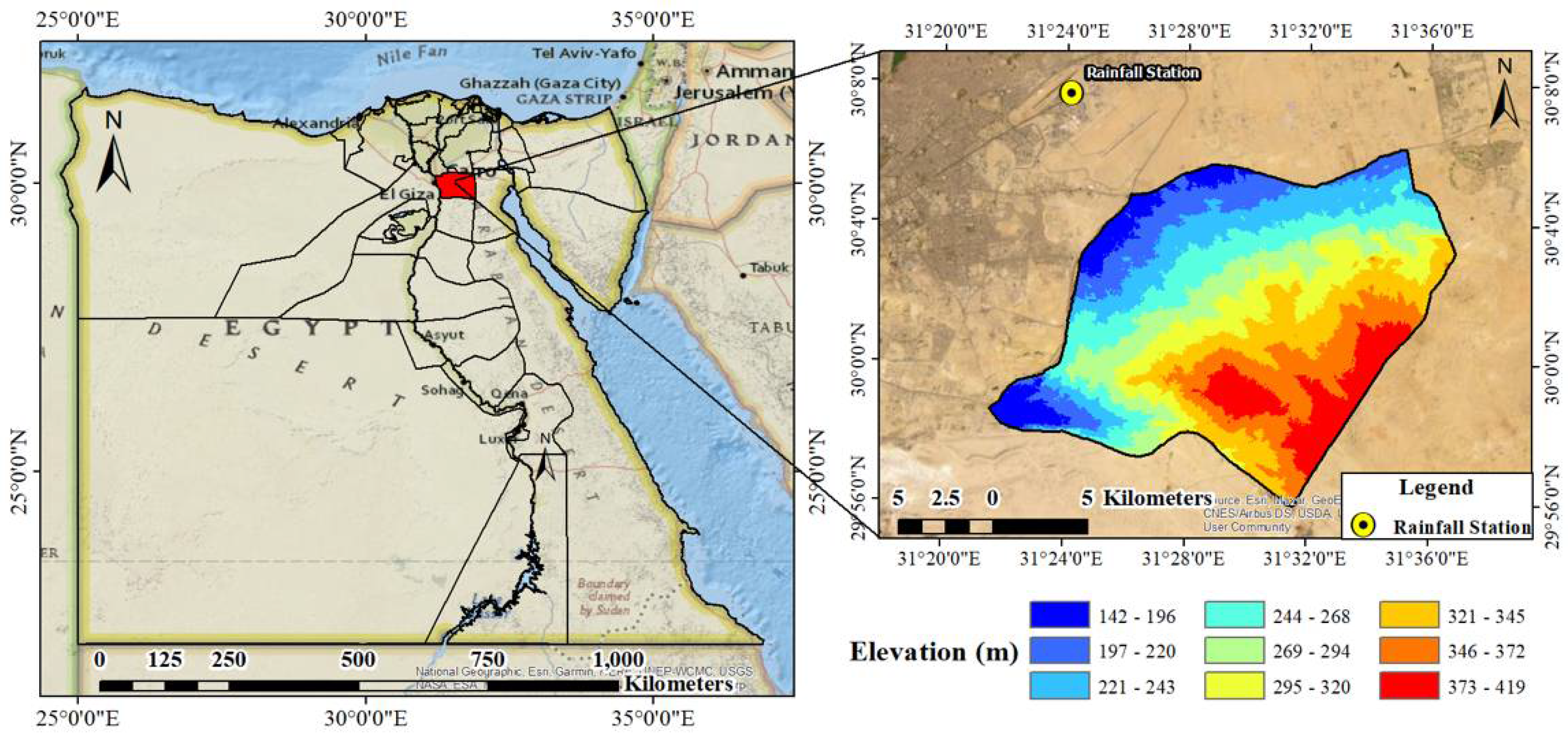

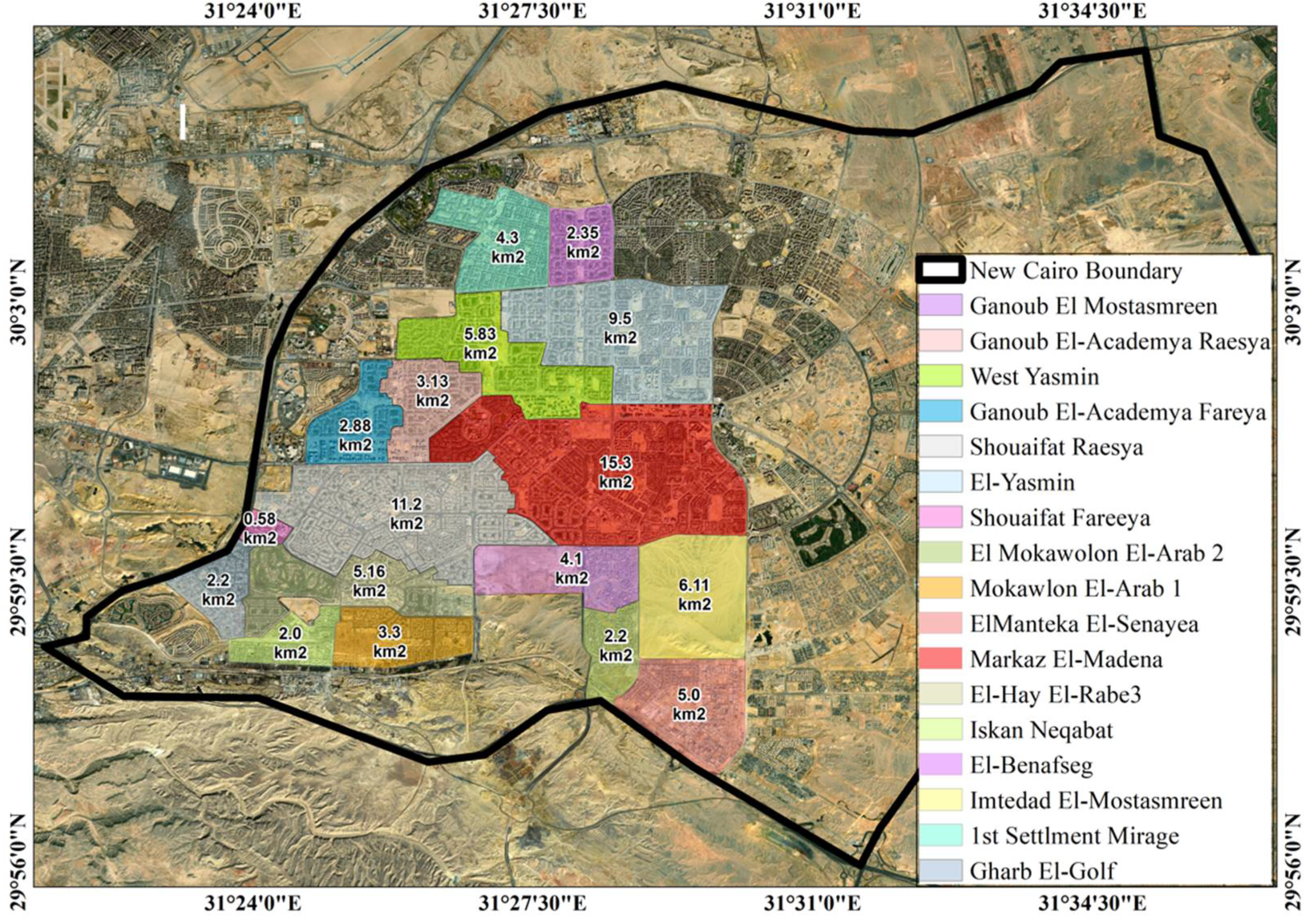
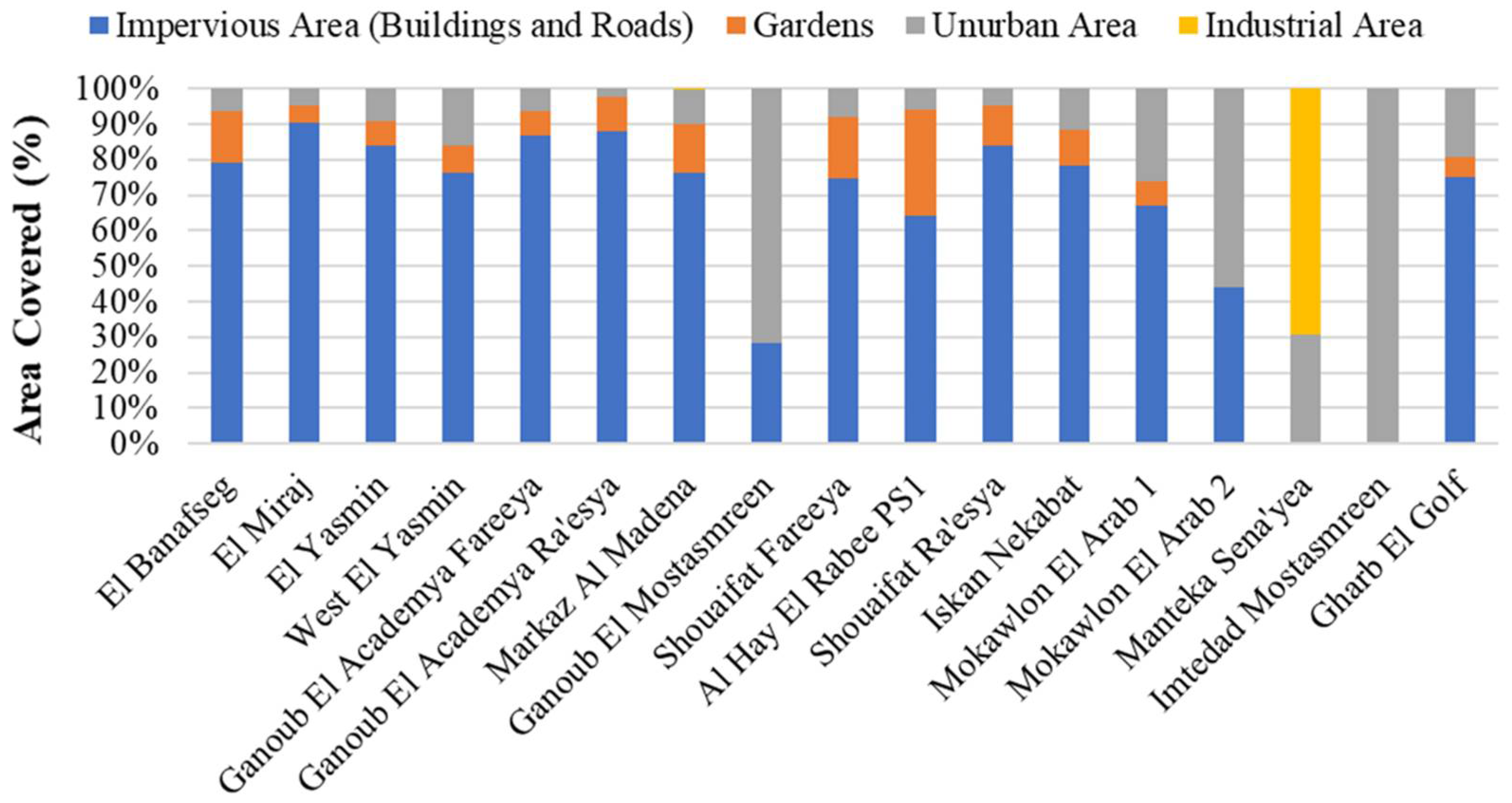
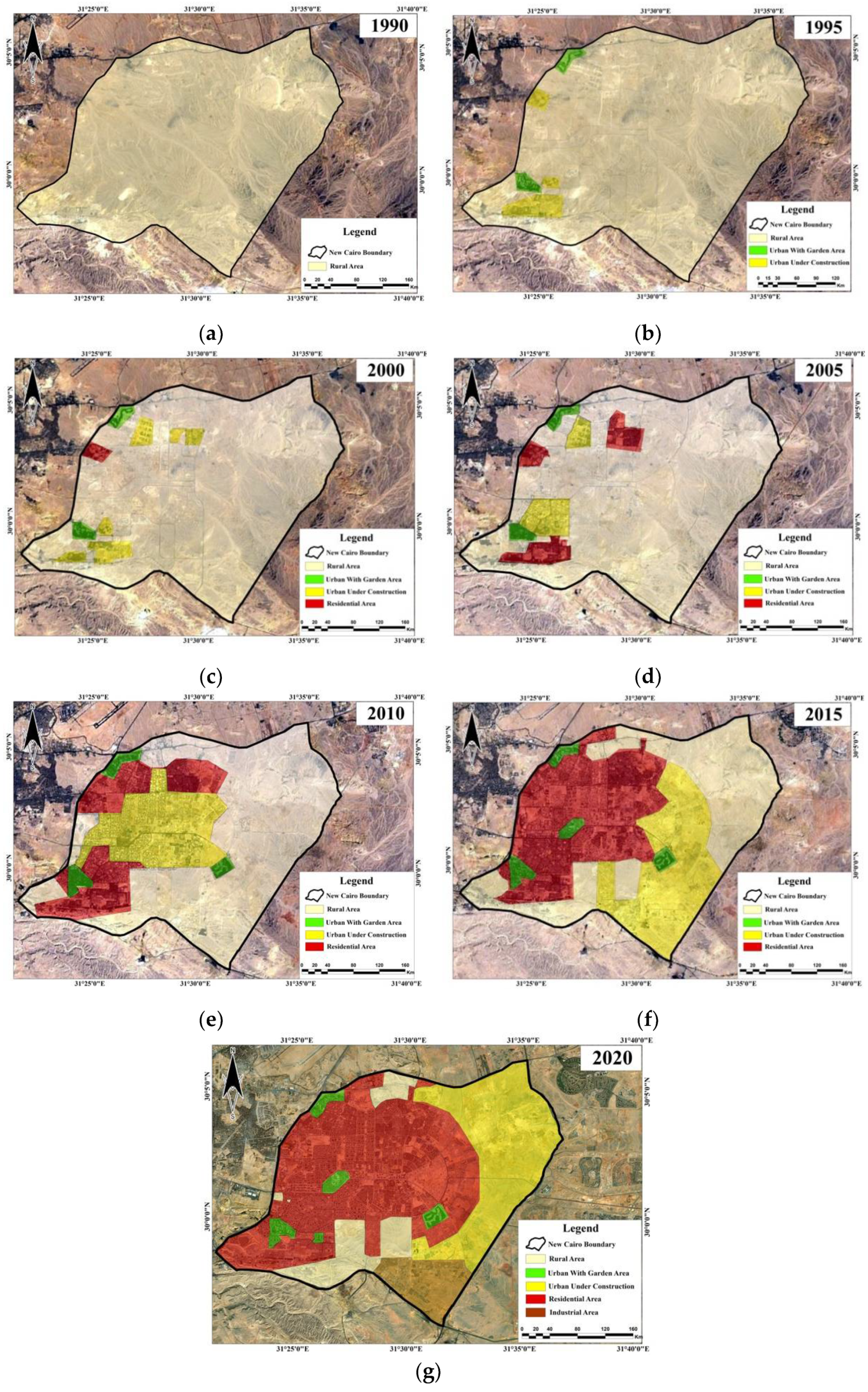
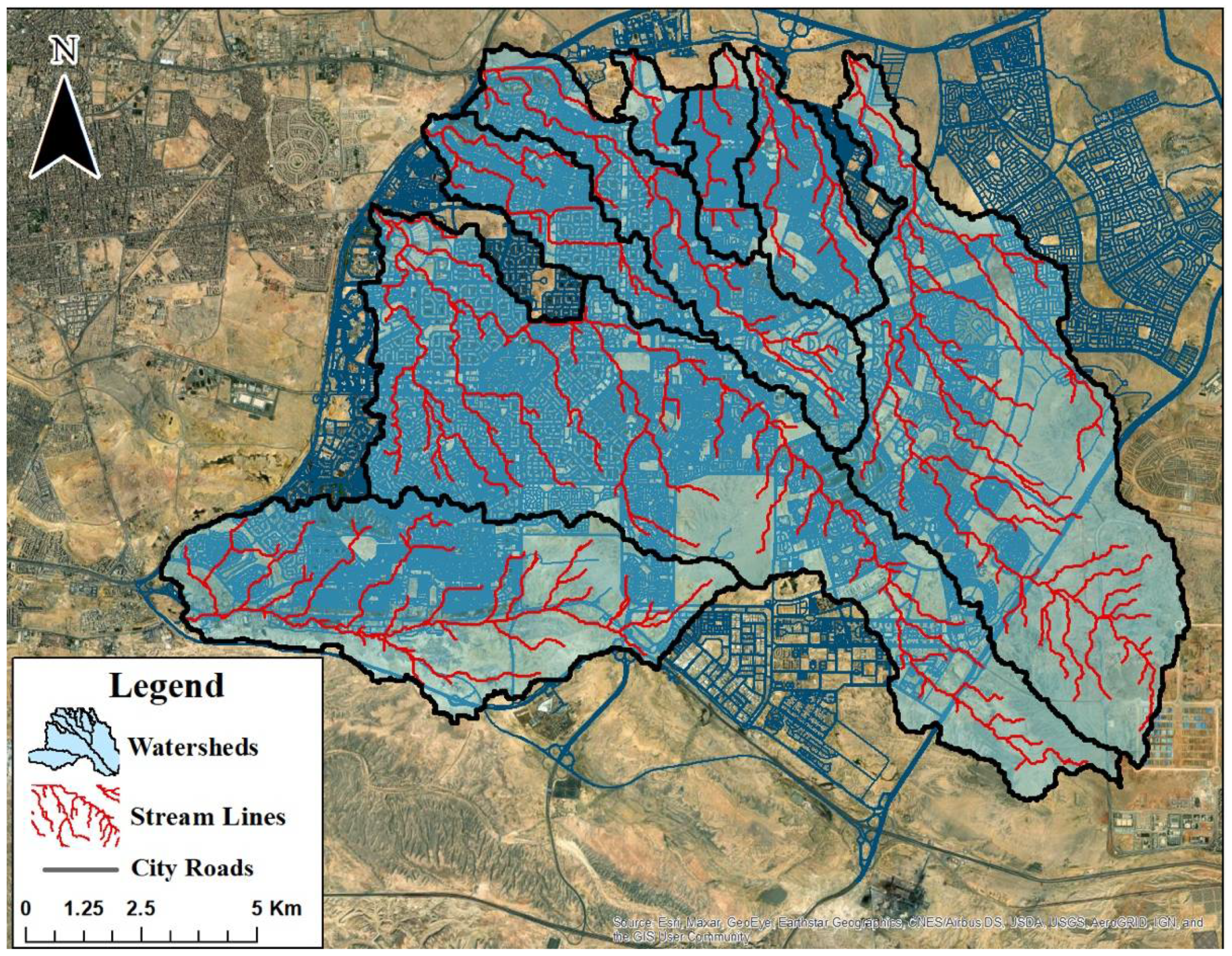

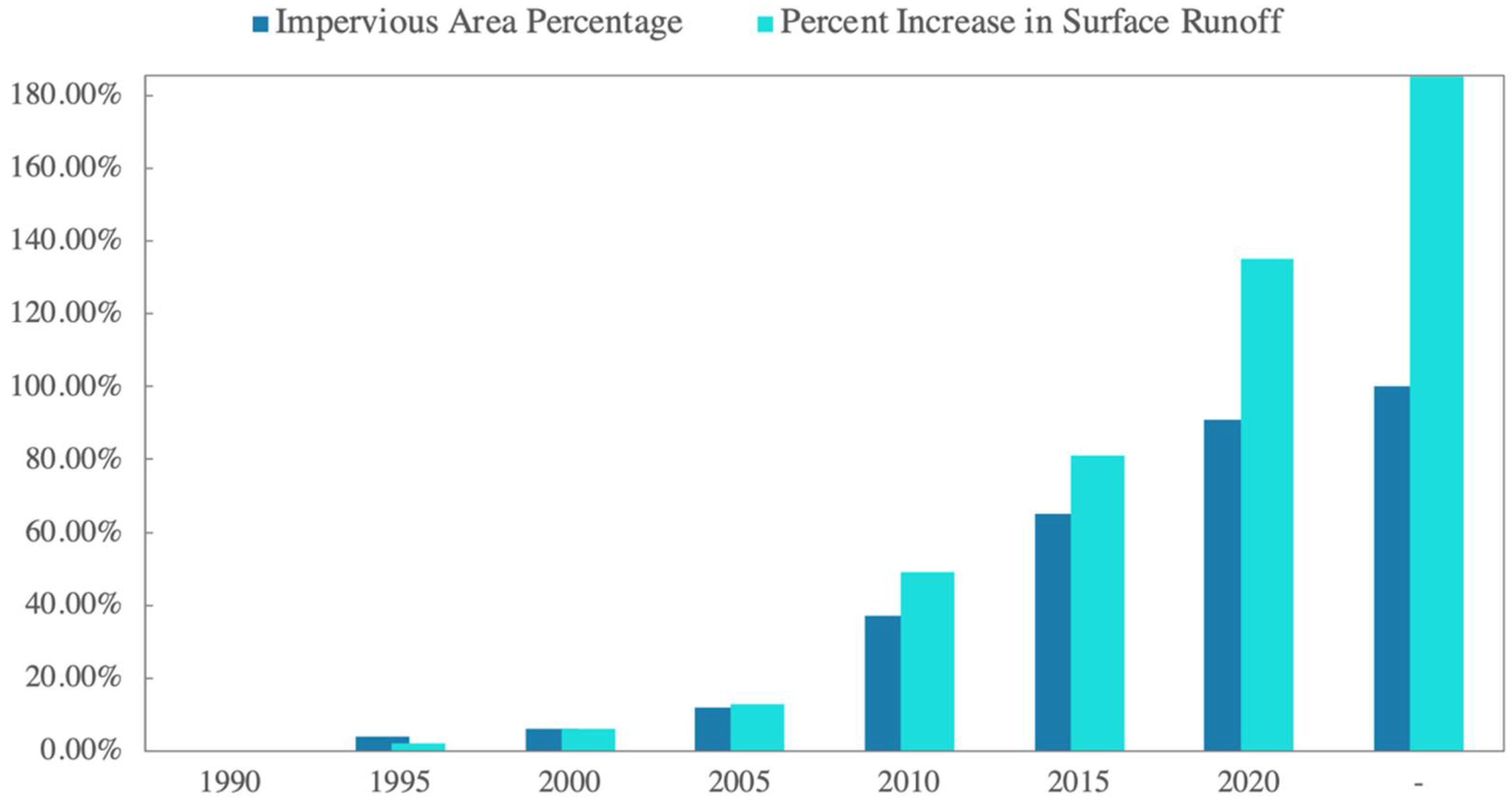
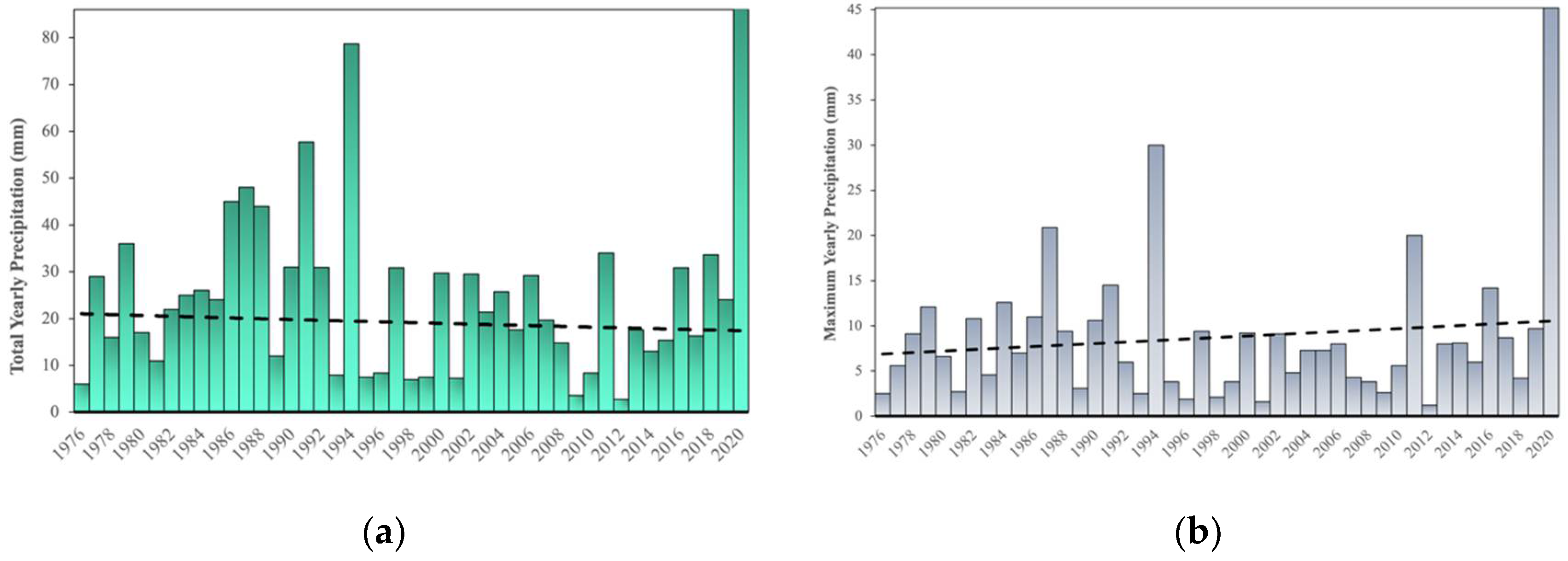

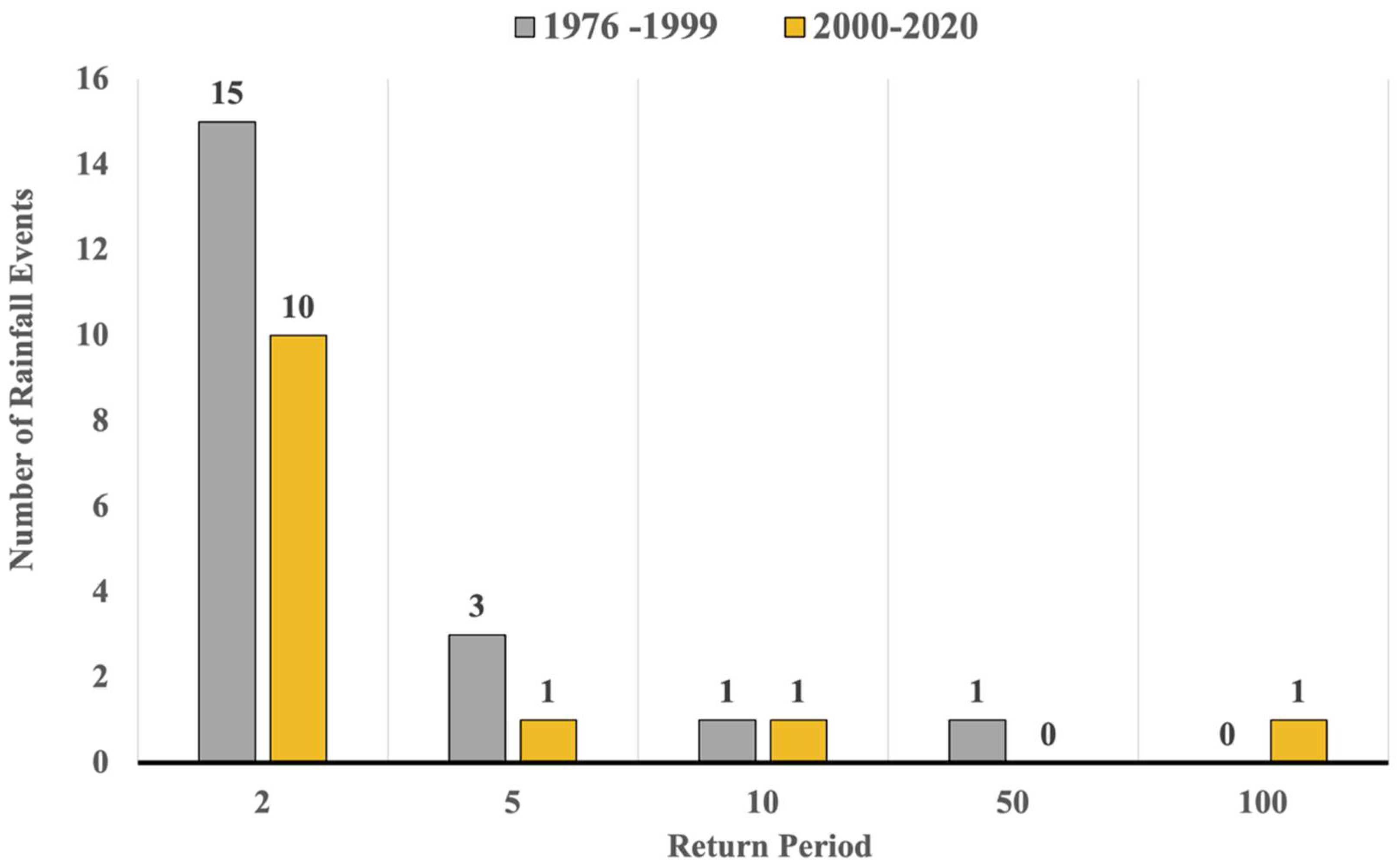
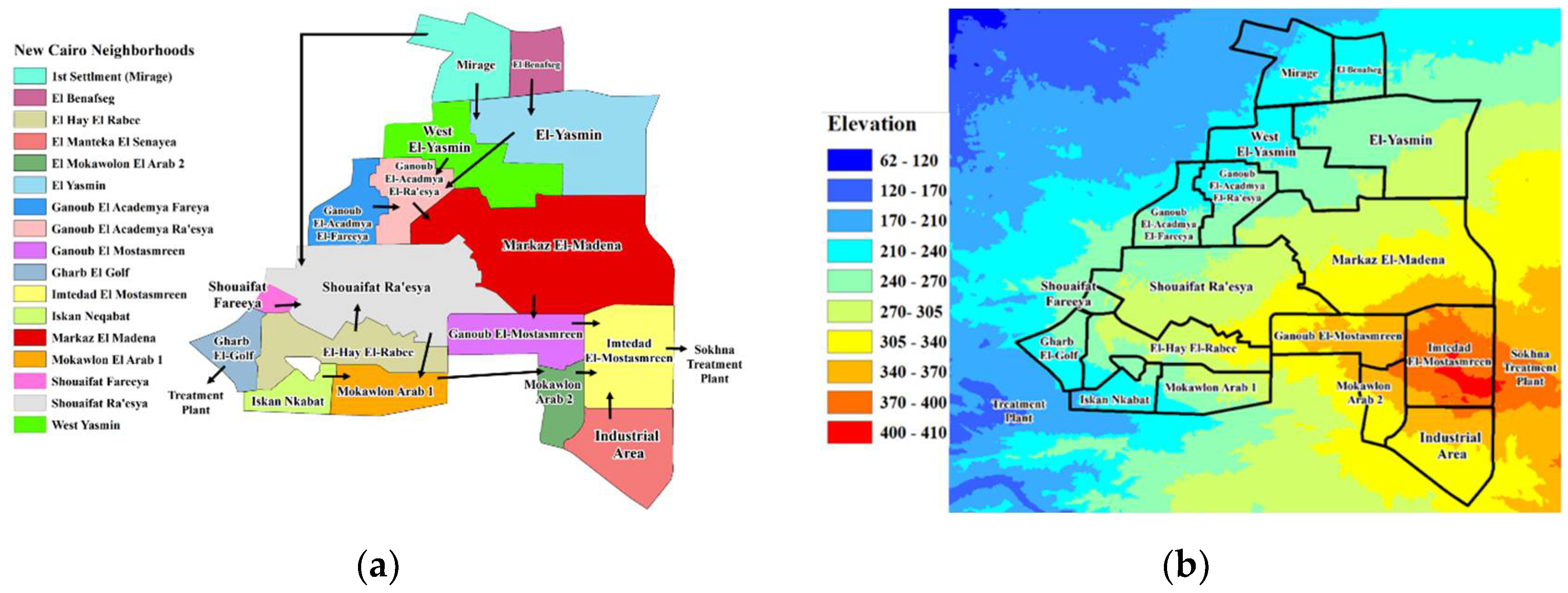
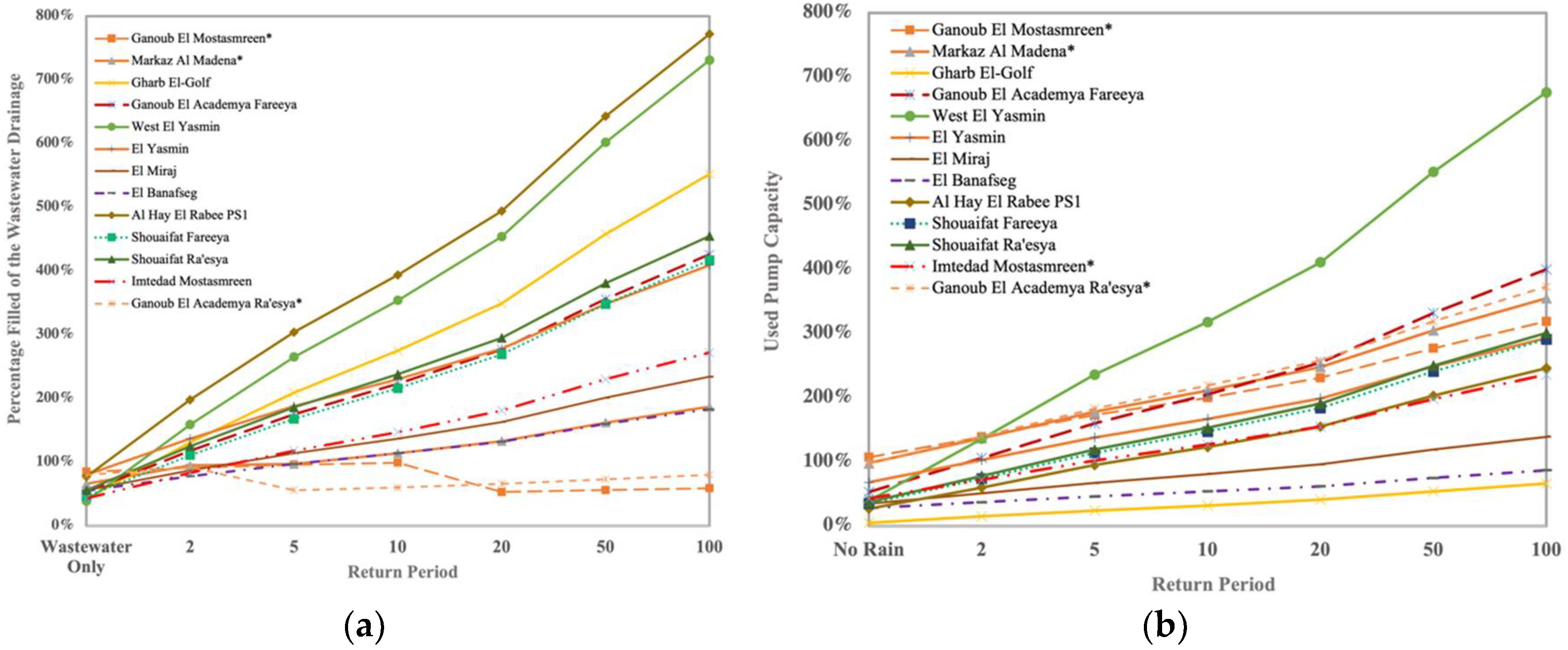
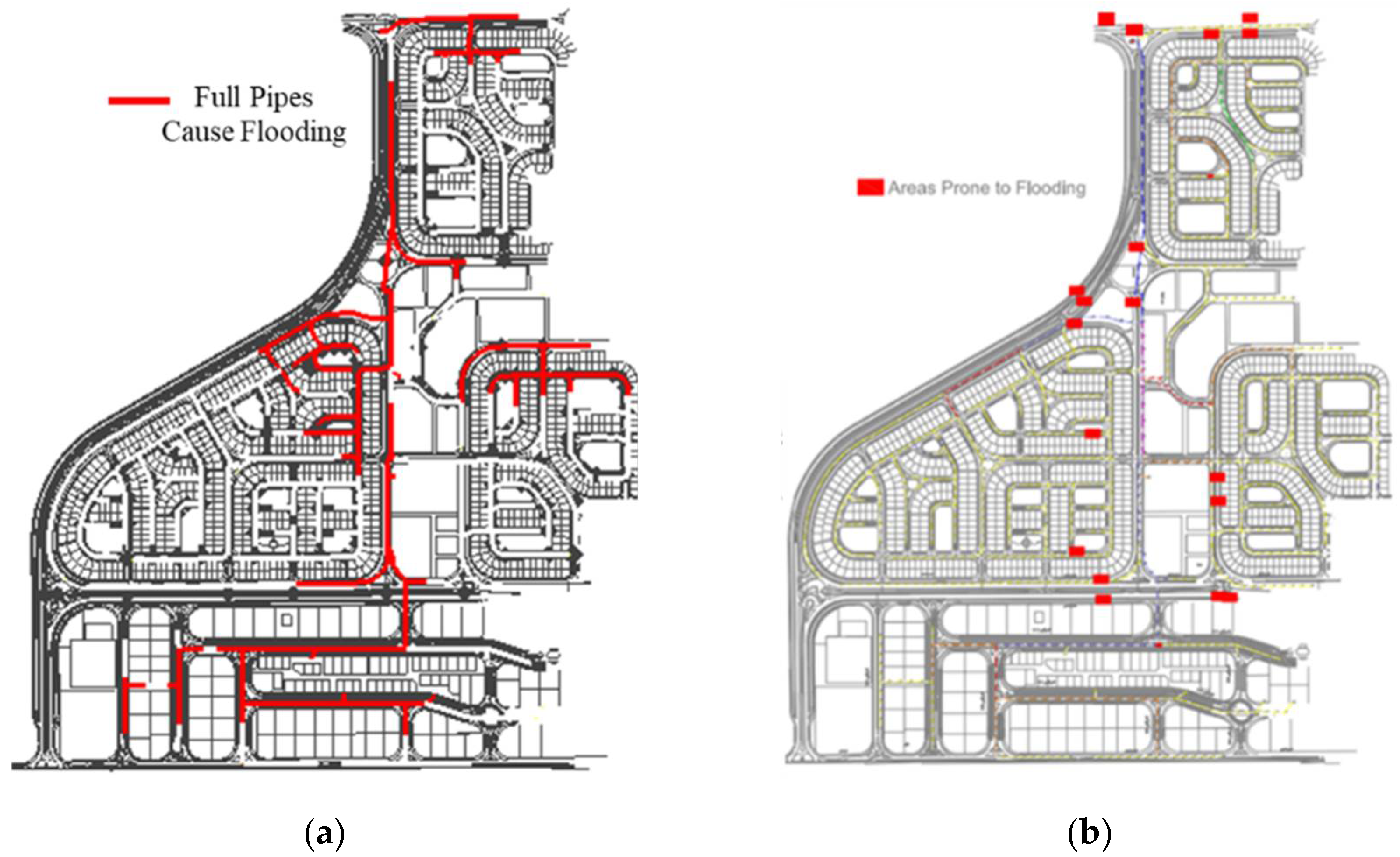
| Return Period | Rainfall (mm/day) | Confidence Interval |
|---|---|---|
| 2 | 6.75 | 4.58–8.92 |
| 5 | 12.7 | 7.92–17.5 |
| 10 | 17.7 | 9.93–25.5 |
| 20 | 23.3 | 11.6–34.9 |
| 50 | 31.6 | 13.4–49.9 |
| 100 | 38.8 | 14.3–63.3 |
| 200 | 46.8 | 14.9–78.7 |
| Statistical Indicator | Equation * | Range | Ideal Value |
|---|---|---|---|
| Mean Absolute Error (MAE) | 0 to ∞ | 0 | |
| Root Mean Square Error (RMSE) | 0 to ∞ | 0 | |
| Coefficient of Determination (R2) | 0 to 1 | 1 | |
| Percent Bias (PBIAS) | –∞ to ∞ | 0 | |
| RMSE-Observation Standard Deviation (RSR) | 0 to ∞ | 0 | |
| Nash Sutcliffe Efficiency (NSE) | –∞ to 1 | 1 |
| Assessment | PBIAS | NSE | RSR | R2 | RMSE | MAE |
|---|---|---|---|---|---|---|
| Very Good | ≤±10 | 0.75 to 1 | 0 to 0.5 | >0.7 | The value can range from 0 to ∞, generally the lower the better | |
| Good | ±10 to ±15 | 0.65 to 0.75 | 0.5 to 0.6 | 0.5 to 0.7 | ||
| Satisfactory | ±15 to ±25 | 0.50 to 0.65 | 0.6 to 0.7 | 0.3 to 0.5 | ||
| Unsatisfactory | ≥±25 | ≤0.5 | >0.7 | <0.3 | ||
| Land Use | C |
|---|---|
| Paved Roads and Building Surfaces | 0.70–0.95 |
| Exposed Soil, Undeveloped Roads | 0.10–0.20 |
| Residential Areas (Flat) | 0.50–0.30 |
| Residential Areas (Mountainous) | 0.50–0.70 |
| Industrial Areas (Light) | 0.55–0.65 |
| Industrial Areas (Heavy) | 0.60–0.80 |
| Paved Roads and Building Surfaces | 0.70–0.95 |
| Year | Percent Imperviousness | Runoff Value (Mm3) | |||||
|---|---|---|---|---|---|---|---|
| 2 | 5 | 10 | 20 | 50 | 100 | ||
| 1990 | 0% | - | 0.33 | 1.06 | 2.21 | 4.40 | 6.60 |
| 1995 | 4% | 0.16 × 10−3 | 0.35 | 1.09 | 2.27 | 4.48 | 6.70 |
| 2000 | 10% | 529 × 10−3 | 0.37 | 1.14 | 2.34 | 4.61 | 6.85 |
| 2005 | 15% | 0.005 | 0.43 | 1.25 | 2.50 | 4.81 | 7.10 |
| 2010 | 40% | 0.075 | 0.79 | 1.83 | 3.32 | 5.90 | 8.40 |
| 2015 | 65% | 0.179 | 1.13 | 2.36 | 4.02 | 6.80 | 9.43 |
| 2020 | 91% | 0.355 | 1.72 | 3.25 | 5.21 | 8.35 | 11.23 |
| - | 100% | 0.636 | 2.37 | 4.16 | 6.33 | 9.86 | 12.74 |
| Indicator | RCP4.5 | RCP8.5 | ||||
|---|---|---|---|---|---|---|
| CNRM | EC-Earth | GFDL | CNRM | EC-Earth | GFDL | |
| RMSE | 6.70 | 9.18 | 10.04 | 10.35 | 8.34 | 5.60 |
| RSR | 0.68 | 1.06 | 1.15 | 1.20 | 1.03 | 1.32 |
| % Bias | −6.12 | 64.43 | −42.60 | −20.33 | −31.27 | −36.54 |
| R2 | 0.64 | 0.09 | −0.13 | −0.04 | 0.20 | −0.16 |
| MAE | 0.29 | 1.90 | 2.04 | 0.97 | 1.48 | 1.21 |
 Weak Correlation.
Weak Correlation.| Return Period | 1976–1999 | 2000–2020 | Percent of Increase | ||
|---|---|---|---|---|---|
| Rainfall (mm/d) | Confidence Interval | Rainfall (mm/d) | Confidence Interval | ||
| 100 | 33.1 | 20.3–45.8 | 38.8 | 14.3–63.3 | 17% |
| 50 | 28.3 | 17.5–39.1 | 31.6 | 13.4–49.9 | 12% |
| 20 | 22.1 | 13.8–30.3 | 23.3 | 11.6–34.9 | 5% |
| 10 | 17.3 | 11.0–23.7 | 17.7 | 9.93–25.5 | 2% |
| 5 | 12.6 | 8.19–17.0 | 12.7 | 7.92–17.5 | 1% |
| 2 | 6.35 | 4.45–8.25 | 6.75 | 4.58–8.92 | 6% |
| Scenario Name | Velocities (m/s) Gravity Pipes | Velocities (m/s) Pressure Pipes to Pump Station | System Overflow (m3/d) | |
|---|---|---|---|---|
| Min. | Max. | |||
| Base Scenario | 33.1 | 20.3–45.8 | 2.13 | - |
| 2-Year Return Period | 28.3 | 17.5–39.1 | 2.28 | 3919 |
| March 2020 Storm | 22.1 | 13.8–30.3 | 2.28 | 17,772 |
Publisher’s Note: MDPI stays neutral with regard to jurisdictional claims in published maps and institutional affiliations. |
© 2022 by the authors. Licensee MDPI, Basel, Switzerland. This article is an open access article distributed under the terms and conditions of the Creative Commons Attribution (CC BY) license (https://creativecommons.org/licenses/by/4.0/).
Share and Cite
Hassan, B.T.; Yassine, M.; Amin, D. Comparison of Urbanization, Climate Change, and Drainage Design Impacts on Urban Flashfloods in an Arid Region: Case Study, New Cairo, Egypt. Water 2022, 14, 2430. https://doi.org/10.3390/w14152430
Hassan BT, Yassine M, Amin D. Comparison of Urbanization, Climate Change, and Drainage Design Impacts on Urban Flashfloods in an Arid Region: Case Study, New Cairo, Egypt. Water. 2022; 14(15):2430. https://doi.org/10.3390/w14152430
Chicago/Turabian StyleHassan, Bassma Taher, Mohamad Yassine, and Doaa Amin. 2022. "Comparison of Urbanization, Climate Change, and Drainage Design Impacts on Urban Flashfloods in an Arid Region: Case Study, New Cairo, Egypt" Water 14, no. 15: 2430. https://doi.org/10.3390/w14152430
APA StyleHassan, B. T., Yassine, M., & Amin, D. (2022). Comparison of Urbanization, Climate Change, and Drainage Design Impacts on Urban Flashfloods in an Arid Region: Case Study, New Cairo, Egypt. Water, 14(15), 2430. https://doi.org/10.3390/w14152430






